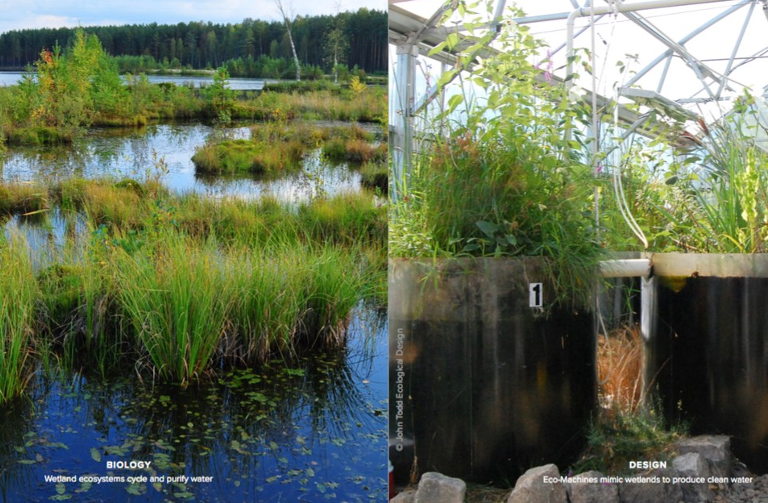“The rule of no realm is mine … but all worthy things that are in peril as the world now stands, those are my care. And for my part, I shall not wholly fail in my task … if anything passes through this night that can still grow fair or bear fruit and flower again in days to come. For I am a steward. Did you not know?” — Gandalf (in J.R.R. Tolkien’s ‘Lord of the Rings’)
John Todd and Gandalf have at least three important characteristics in common. They both have been around the block for a while and draw their art from many years of experience. They are both wizards, but while Gandalf is first called ‘The Grey’ and later ‘The White’, John would be appropriately named ‘The Blue-Green’ since he is a magician-healer of life in water and on land. This relates to the third characteristic: both of them are deeply and passionately committed stewards of life on Earth.
“There are literally thousands of ways that stewardship can help heal and transform our wonderful Earth.”— John Todd
Time magazine called John a ‘Hero of the Earth’ in 2000. He is one of the early pioneers of ecological design and engineering. John contributed a briefing paper to the United Nations’ first conference on the environment at Stockholm in 1972. His professional work spans the entire history of humanity’s slow process of waking up to looming ecological collapse and climate cataclysm. He is the inventor of a number of ecological engineering patents and has pioneered integrated ecological design solutions in food production, wastewater treatment, bioremediation of polluted water and soils, architecture, marine transport, energy production and landscape restoration.

Ecological design pioneer and UVM professor emeritus John Todd (Photo: Sally McCay)
Sparked into action by Rachel Carson’s Silent Spring John Todd and his wife Nancy Jack-Todd, together with their friend Bill McLarney, founded the New Alchemy Institute (N.A.I.) in 1969 “to restore the land, protect the seas, and inform the Earth’s stewards.” I have written about the significance of the N.A.I. before and Nancy tells the institute’s story very well in her book A Safe and Sustainable World: The Promise of Ecological Design.
I first met John and Nancy at a course on Ecological Design they taught with David Orr at Schumacher College in 2002, while I was working on my Masters in Holistic Science. It is no exaggeration to say that the three of them changed my life. I owe them a huge debt of gratitude for igniting my passion for the power of design to transform the world for the better.
John made me comprehend the potential of ecological design to heal the Earth, restore the damage we have done, and create conditions conducive to all life while meeting human needs through “elegant solution predicated by the uniqueness of place.”
In 2004, I facilitated another course with John and Nancy at Schumacher College on Nature Inspired Design. At the time John was also my second PhD supervisor and I was working on my 750 page doctoral thesis on ‘Design for Human and Planetary Health’ mentored by another remarkable ecological design pioneer, Prof. Seaton Baxter, at the ‘Centre for the Study of Natural Design’ at the University of Dundee in Scotland. After graduation in 2006, I visited John and Nancy in Burlington Vermont where John was teaching and then drove to their home on Cape Cod with them. Below is a 40 minute interview we recorded during that visit.
This interview was recorded in 2006 in John and Nancy’s living room. It explores their pioneering work in ecological design and engineering, including the history of the New Alchemy Institute they co-founded in 1969.
HEALING EARTH — An Ecologist’s Journey of Innovation and Environmental Stewardship is a rare gem of a book and a valuable resource for anyone ready to engage in ecosystems restoration or regenerative development. The book can be regarded as John’s memoirs, distilling 50 years of professional practice in ecological design and engineering into a delightful and informative read. It offers a passionate testimony to humanity’s potential to create conditions conducive to life by healing the Earth and her people.
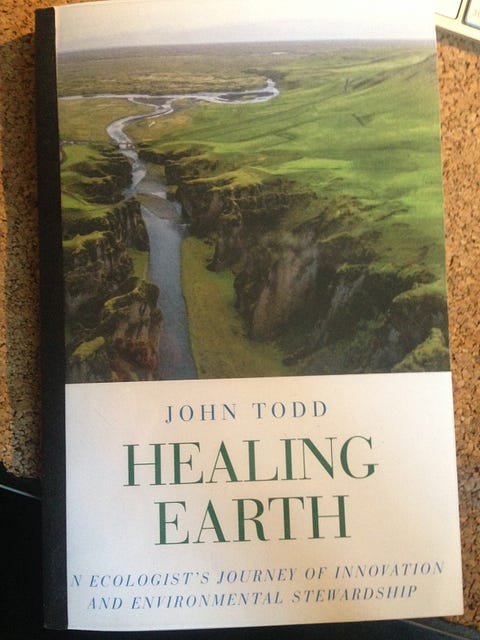
Photo of my galley copy of John’s new book. I feel privileged to have been asked to write a pre-release review for my former (2nd) PhD supervisor who has influenced my own work in profound ways and continues to do so.
In the introduction to the book, Janine Benyus, co-founder of the Biomimicry Institute, writes: “When I encourage people to go beyond the mimicry of just one species or one part of one species, I point towards John’s work as an ecomimic — an innovator who emulates the whole. … Healing of water, soil, climate and community can spread, and humans can be a nucleus of that healing.” John Todd’s book shows us how and offers inspiring examples of his projects around the world. To top it off the book is full of many beautiful design drawings.
John has been guided in his work by two convictions: “that which is damaged can be healed” and “do good things in bad places.” He has been deciphering “life’s operating instructions” over more than half a century of dedicated apprenticeship of life and this has resulted in many ingenious innovation dedicated to healing degraded ecosystems and meeting human needs.
“I am an optimist at heart, but I have tested my optimism in places that have been degraded and almost destroyed by abuse from humans. Toxic waste sites, polluted waters, and ravaged environments have been home to some of my projects. My efforts have resulted in some remarkable changes. This stewardship road has turned into a path of learning and of wonder at the power of the natural world to benefit humanity, if only we could understand its instructions and work with the living world in a new kind of partnership.” — John Todd
John speaks of three orders of ecological design: “living technologies” that assemble diverse designed ecosystems mimicking natural ecosystems and their functions, like his ‘eco-machines’ and ‘floating restorers’, are examples of First Order Ecological Design. Industrial ecology and eco-industrial parks are examples of Second Order Ecological Design which “brings together processes and materials that are not normally connected.” The creative challenge ahead is Third Order Ecological Design that “attempts to ecologically fuse First and Second Order Design into a much broader frame of reference that includes economies and social institutions.” John’s vision of Third Order Ecological Design speaks of nothing less than our creative potential to reinvent the human presence on Earth and manifest that change through technologies and settlements that regenerate and restore thereby replacing today’s destructive and exploitative technologies and institutions.
“We are beginning to envision and initiate the large-scale transformation and restoration of whole regions that have been ecologically crippled by centuries and even millennia of misuse and abuse. I am convinced that an ecological renaissance is emerging in our time. Its promise is climate stabilization and a living bounty for us all.” — John Todd
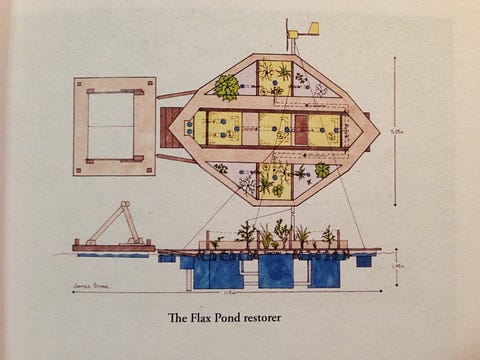
Image from the book
In HEALING EARTH John takes us through a wide range of scales and areas of application of ecological design. All of them illustrate the application of a theory of ecological design he has developed and refined throughout his life. The book is full of visionary aspiration yet backed by an impressive track record of innovation and achievement as an Earth healer.
“… perhaps for the first time in modern history our knowledge of the natural world has reached the stage where we can look into nature and see a coherent body of ecological information there. Life’s inner workings are being decoded and its extraordinary complexity revealed. We are learning that nature has a set of operating instructions of immense significance, which I believe are critical to human survival.” — John Todd
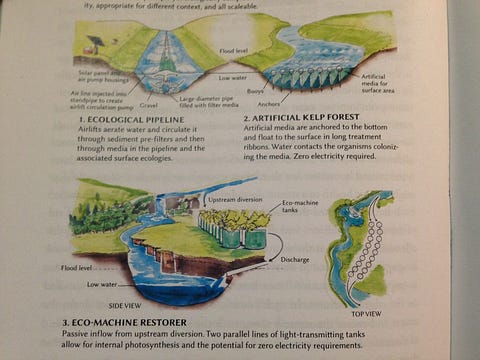
Image from the book
John takes the reader through the thirteen guiding principles he has so far found useful in the design of living technologies. He illustrates these principles through examples from fresh water aquaculture systems he has developed. Much of his work has been focussed on helping to clean up polluted waterways through ecological engineering solutions. He has invented a series of different ‘restorer’ technologies from eco-machines to floating restorers and more.
Other examples in the book include the design for a ‘saltwater aquaculture eco-machine’, a pilot project in China to clean up a section of a highly polluted urban canal, and even new sail boat designs to usher in the return to what Emerson called the ‘eolian age’ — when cargo transport by sea once again is powered by the wind. One of John’s long standing but yet unrealized visions is to build a series of “ecological hope ships for marine pollution reduction” called ‘Ocean Restorers’. These ships would be catamarans with their “treatment technologies suspended between the two hulls.”
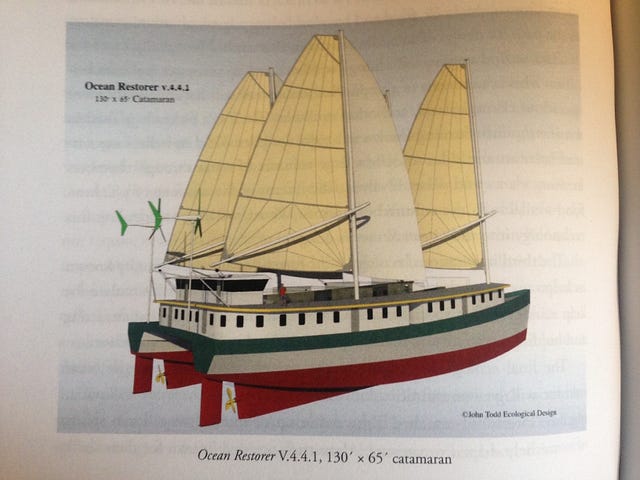
Image from book
I was also fascinated by John’s account of his work for the Lewis Foundation to investigate possibilities of how to deal with the disastrous aftermath of strip mining and mountain-top removal in the Appalachians. His proposal to the foundation for ‘A New Shared Economy for Appalachia: An Economy Built Upon Environmental Restoration’ was later submitted for and won the Buckminster Fuller Challenge. John writes:
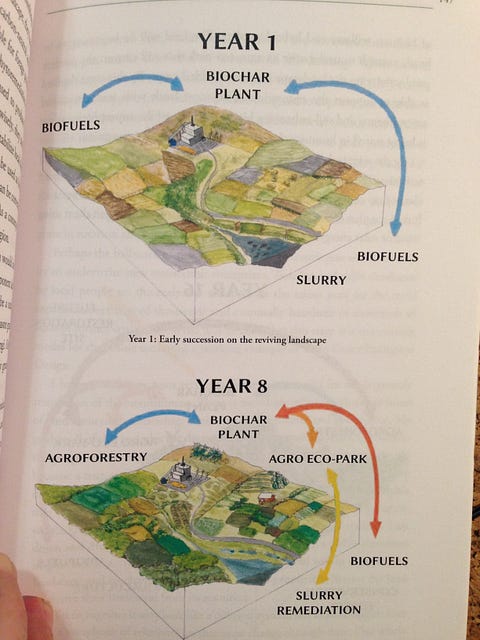
“My approach to restoring the coal-mined land of Appalachia was predicated on a simple, fundamental idea, namely that soils define societies and that the quality of their soils dictate to a high degree their durability and fate. My efforts would revolve around creating deep, rich soils … where there was none.” John’s plan was to “jump start succession on the landscape” through landscape restoration, agriculture, and agroforestry in combination with techniques like remineralization with ground rock, and widespread use of beneficial bacteria and fungi, liquid compost and biochar.
The 16-year plan would drive the restoration of healthy ecosystems functions proposed the use of regenerative agriculture and carbon farming techniques to bring biomass and carbon back into the soil, ecological engineering to bioremediate the legacy of the mining industry and restore local streams and aquifers, and agroforestry to reforest the area in an ecologically diverse and economically productive way, while providing a source of wood for the production of biochar in support of soil building.
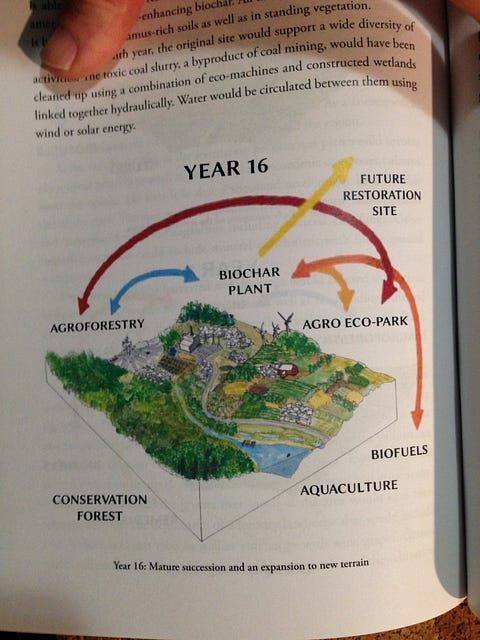
“By the sixteenth year, the original site would support a wide diversity of activities. The toxic coal slurry, a byproduct of coal mining, would have been cleaned up using a combination of eco-machines and constructed wetlands linked together hydraulically. Water would be circulated between them using wind or solar energy.” John continues: “When the job is done, the environmental clean up technologies can be converted to commercial fish farming. When natural springs have returned to the landscape, as they undoubtably will, they can be employed to support trout culture. Ponds, designed to capture and hold rain water, could support the cultivation of catfish and buffalo fish. By this time the biomass tree plantations will be at peak production. The orchards and vineyards in the sixteenth year will be producing bountiful harvests and will employ an increasing number of local people. Valuable nut trees, such as walnuts, will be managed for timber, as well as their nuts. Livestock including cattle, sheep, and pigs will be part of the landscape and will graze in rotation amongst the tree-dappled pastures” (p.148–149).
To make such visionary projects replicable realities John introduces an enormously important framework for thinking more long-term about the process of ecosystems restoration as a pathway to bioregionally focussed economic and social regeneration. He calls this framework the ‘seven successional stages to regeneration’ (see image below) .
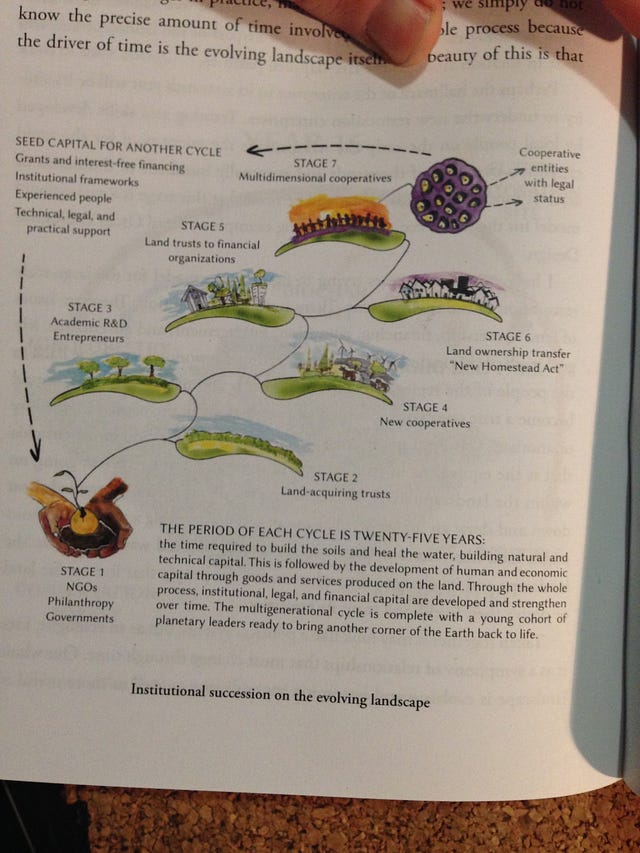
John ends his deeply informative book by highlighting the work of other pioneers in the growing movement of Earth healers and stewards of life. He speaks highly of the work of Alan Savory, recognizes the critical importance of the work of Bill Mollison and David Holmgren in introducing permaculture to the world and creating a global movement that has skilled-up many thousands of Earth healers around the world. He also celebrates Janine Benyus for her work with the Biomimicry Institute, the work of Carl Hodges on the use of halophytes (plants with high tolerance to salt water) to re-green deserts; and John Liu for his leadership in promoting large scale landscape restoration through his work as a documentary film-maker (see Green Gold) and key instigator of Ecosystems Restoration Camps.
“My hope for the future is predicated on very large number of people committing themselves to a life of Earth stewardship. Millions of such people will be needed to help stabilize climate and feed growing populations. These budding stewards will have to be trained to possess the skills needed for the ecological restoration of the planet. Today their numbers may be measured only in the thousands, or even tens of thousands at best. The good news is that knowledge and techniques are now widespread, and even better news is that the large scale training for such a task has begun.” — John Todd
John Todd on ‘The Ecological Design Revolution’ at Bioneers in 2014 (24mins)
I could not recommend this book more highly to anyone interested in the history, present and future of humanity’s path towards becoming mature members in the community of life and humble stewards capable of creating conditions conducive to life. John and I are now both members of the advisory council of the Ecosystems Restorations Camps Foundation which is building the necessary partnerships to scale-out regeneration glocally by offering training opportunities for the Earth stewards of the future, which we will depend on to make the 21st Century the Century of Regeneration. Creating a thriving future for all of humanity and life on Earth depends on us all achieving this task together.
Note: The book will going on sale January 29th, 2019. It is published by North Atlantic Books and available on Amazon.


